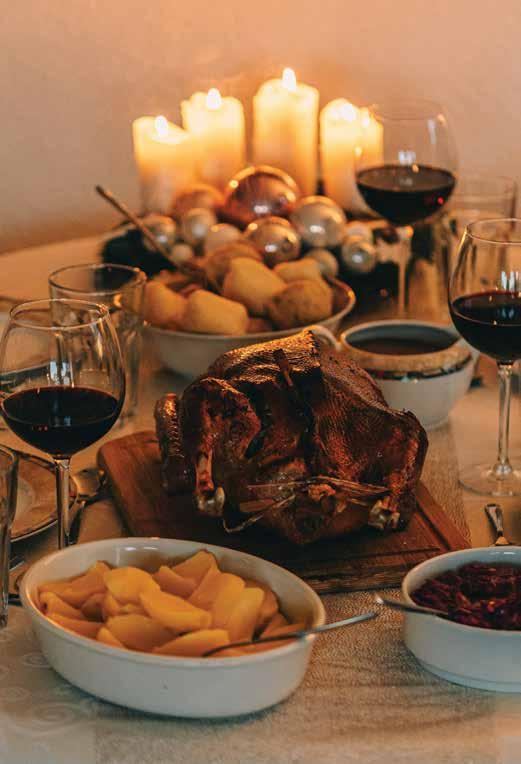









LIFESTYLE LETTER











LIFESTYLE LETTER
In this season of gratitude, we often find ourselves reflecting on the many blessings in our lives. Thanksgiving encourages us to slow down, embrace the present, and appreciate the people and moments that bring us joy.
This month, I’ve been especially grateful for the small, everyday moments that make life beautiful: the laughter of loved ones and quiet mornings with a cup of coffee.

Our November issue is dedicated to stories of gathering, giving back, and celebrating the people and organizations that makes our city such a special place. We’re endlessly thankful for our advertising partners, whose support allows us to bring inspiring stories to your doorstep each month, and for the readers who make it all worthwhile.
As we prepare to gather with loved ones, let’s take a moment to reflect on what truly brings meaning to our lives. This holiday season, may we find contentment not in possessions or accolades but in the connections we nurture and the good we do for others.
Wishing you and your family a season of gratitude and grace, CHELSEY JUAREZ,
November 2025
PUBLISHER
Chelsey Juarez chelsey.juarez@citylifestyle.com
CONTRIBUTING WRITER
Angela Broockerd angela.broockerd@citylifestyle.com
CEO Steven Schowengerdt
President Matthew Perry
COO David Stetler
CRO Jamie Pentz
CoS Janeane Thompson
AD DESIGNER Rachel Kolich
LAYOUT DESIGNER Kirstan Lanier
QUALITY


Learn how to start your own publication at citylifestyle.com/franchise.

We are open to service all your jewelry needs at both locations.





Recent data shows housing inventory increasing as buyer demand shows signs of slowing. The absorption rate (the rate at which homes are being “absorbed” by buyers) has slid for three consecutive months, from 74.7% in June to 64.4% in August.*
Mortgage rates are predicted to hold steady through the end of 2025, dipping slightly by the end of 2026.
The latest predictions suggest 30year fixed mortgage rates will likely remain in the mid -6% range, potentially dipping slightly to the high 5% to low 6% range by the end of 2026.
While prices are projected to remain steady, some of the overwrought competition may subside.
A more stable market is good news for everyone. This stability may help to take some of the pressure off buyers who have been disappointed by losing out in highly-competitive, multiple-offer situations.

Michael Kurowski Global
Advisor

The holidays have a way of calling us back to what matters most—faith, family, compassion, and the quiet but powerful act of giving. As lights go up and calendars fill, there are still many who sit in silence, carrying burdens too heavy to bear alone. But what if this season, you could be the spark that changes everything for someone else?
The founders of City Lifestyle, through their private foundation, are once again launching its annual Christmas Giving Campaign—a heartfelt effort to seek out and support individuals and families who have quietly fallen through the cracks. The mission is simple: to bring light, dignity, and hope to those who need it most.
Since its beginning just four years ago, this initiative has grown from a humble idea into a life-changing movement. Last Christmas alone, more than 200 families across the country received unexpected support—financial relief, but also something even more powerful.
“We don’t just send checks,” says Steven Schowengerdt, CEO and founder of City Lifestyle. “We send a message: You are seen. You are loved. And you are not forgotten.”
Together with City Lifestyle President Matthew Perry, Steven has helped shape this into a tradition that goes far beyond charity. “This is about community,” Matthew adds. “We believe we’ve been blessed, so now we get to be a blessing.”
Every story begins with a nomination. Often, it’s a neighbor, coworker, friend, or teacher—someone who’s been quietly carrying too much for too long. One past recipient, after receiving unexpected support during a time of deep personal struggle, wrote:
SCAN TO NOMINATE

“We send a message: You are seen. You are loved. And you are not forgotten.”
“Beyond the very practical solution of receiving funds to fix my car, this thing you guys worked together to do is bigger than that. I carry the Christmas card you sent in my purse. When things get really hard, I pull it out and remember what it felt like to be seen. That card represents hope— that change for the better is possible. I’m not sure how many people get to carry hope around in their purse. But I do.”
Another wrote in after her husband was diagnosed with aggressive brain cancer and unable to work:
“This support has blessed our family not only financially, but emotionally and spiritually as we trust God to meet our needs throughout this difficult time. Thank you to our anonymous friend and to your foundation. What a joy and gift to be part of God’s family!”
Each year brings countless stories like these—real lives touched by simple acts of kindness. Some use the funds to pay overdue bills, others to afford groceries, medication, or repairs. But no matter the circumstance, the impact is the same: hope is restored.
This season, you have the opportunity to be part of that. The campaign is now open to nominations—completely confidential and prayerfully considered. Whether it’s someone battling illness, facing unemployment, or just in need of a helping hand, you can bring them a moment of grace that will ripple far beyond Christmas morning.
“Knowing my mom was chosen filled my heart with indescribable joy,” said another past recipient. “Your generosity doesn’t just brighten her life; it inspires hope and faith in all of us. It enables her to stay in her home and get back on her feet.”
Nominations are open from November 1st to December 5th, 2025. To submit someone you know, simply scan the QR code or visit @CityLifestyle on Instagram, where you’ll find the nomination form in the bio.
This holiday season, let’s give more than gifts. Let’s give each other the gift of being seen. Because sometimes, the smallest gesture becomes someone’s greatest miracle.
To nominate someone in need, visit: KingdomBuildingFoundation.org or scan the QR code.

Veterans and Wild Mustangs Rebuilding Together

Some people, some places, you just know are special. It’s in the way they speak with sincerity, the way they make you feel the moment you arrive. There’s a place like this in Bull Valley, Illinois.
Operation Wild Horse is a 501(c)(3) nonprofit run by Patti Gruber and her assistant director, Megan Townsend. On a blazing August day, I had the opportunity to visit. The winding, tree-lined drive gave way to open pastures where mustangs grazed lazily in the sun. As I pulled in, the sound of crunching gravel mingled with the soft nickers of horses who had gathered along the fence line.
By the time I parked and stepped out, Patti was already walking toward me, greeting me with a warm smile and a firm handshake. Her dusty jeans and worn boots painted a picture of a woman who works hard and leads with heart. As we exchanged pleasantries, a loud voice rang out from a passing car. Patti laughed, “We get that all the time, either a veteran shouting a greeting to their horse, or a neighbor just saying hi.” It was a small moment, but it told me everything I needed to know, this was a place built on connection, belonging, and love.
Operation Wild Horse pairs U.S. military veterans with wild mustangs, creating a space where trust is rebuilt, one quiet moment at a time. The program operates out of the Bull Valley Equestrian Center on 10 acres of leased land, and since its founding in 2017, it has grown into a lifeline for hundreds of veterans. Patti’s vision stems from the belief that veterans and mustangs share something profound, both are resilient, misunderstood survivors who have endured harsh conditions and carried scars, visible or not.
Many of the horses that arrive here were considered “throwaway” animals, destined for holding pens or worse. Most come from the Bureau of Land Management (BLM), which manages wild horse populations across the American West. For decades, the BLM has rounded up mustangs from public rangelands when herds grow too large for the available resources, placing them in holding facilities and up for adoption. “That’s where we step in,” Patti explained. In addition to BLM adoptions, many horses are donated by veterans or the families of veterans, each animal carrying its own legacy of resilience.
When a new veteran joins the program, there’s no assignment or pressure. Instead, they’re invited to spend time with every horse in the herd, walking quietly through the pastures, letting instinct and emotion lead the way. “They usually bond quickly,” Megan said. “It’s almost like the horse picks them.” These initial meetings often mark the start of a partnership that becomes deeply personal, built on patience, trust, and mutual respect.
“They’re literally changing lives,” Megan says, “both the horses’ and the veterans’.” That truth becomes clear in every story shared, every quiet interaction between horse and rider.
Take Valor, for example. Once a band stallion in the wild, he bears the scars of years spent fighting to protect his herd. He’s not rideable and remains wary, but Patti says he’s one of their best teachers. “Valor physically shows the invisible scars of our veterans,” she explained. His reactions mirror the emotions of those around him, tense when they are anxious, calm when they



are grounded. In that way, Valor helps veterans see their inner state reflected back at them, offering lessons no words could teach.
Throughout my visit, I met veterans who brought the program’s mission to life. Marty, a 77-year-old Marine, rides Jelly, a mustang donated by a Marine sniper’s father. Patti fussed over him like family, teasing him about the candy she knows he keeps in his car and adjusting his hat so the pins from his service could be seen. Their affection was genuine, and it was clear this wasn’t just a program; it was a community.
Then there was Rich, a legally blind Air Force veteran, who rides Firefly. His wife, Mary Ann, drives him from Milwaukee each week. “He never asks for anything,” she says. “But when he saw a documentary about Operation Wild Horse, he said, ‘I’d like to meet those horses.’ I knew then I’d make it happen.” For the past year, the two have come together. She rides alongside him, both finding peace and purpose in the barn.

“Healing here isn’t loud or linear. It happens in small gestures, in the patience, gentleness, and presence.
Sometimes it’s a light returning to someone’s eyes, a horse finally relaxing under a gentle hand, or a quiet realization: I am not alone.”
Dan, a first responder with the sheriff’s department, began attending after a particularly traumatic call. A veteran friend suggested he give it a try. He’s been riding Bango for three months now. On my second visit, he stopped by just to see “his” horse. The way Bango nuzzled him and the quiet pride in Dan’s expression painted a picture of mutual healing.
Two Army veterans, Susan and Meg, showed off their horses’ skills on the obstacle course, guiding them through patterns of trust and cooperation. Both women exuding a calm, quiet strength. They shared that equal to the healing the horses provide, is Patti’s ability to create a welcoming environment.

While there’s structure to the program - veterans are assigned times so Patti and Megan can check in if someone misses - the doors are always open. “If a veteran needs us, they can come anytime,” Patti said. They conduct 80–100 sessions each month, sometimes with one veteran, sometimes with twenty, equating to more than 10,000 sessions since opening their gates. Wednesdays are reserved for women veterans, and though it’s scheduled time is 7–9 p.m., Patti laughs that it usually runs closer to 6–10. “If there’s a need,” one veteran told me, “Patti will do her best to fill it.”
The herd itself is a colorful collection of personalities, consisting of 16 mustangs, 2 mini horses, 7 burros, 1 mini donkey, a goat named Muffin, and two ducks, Coaster and Becky, who no longer lay eggs but are loved (and teased) just the same. Each animal carries a story. There’s Pearl Snap, a striking black-and-white paint who knows he’s beautiful; Ranger and Twenty-Two, the youngsters of the group; and Jack, the oldest mustang, now retired but constantly doted on. Megan’s horse, Little Man, is one she trained herself, a testament to patience and persistence.
Patti’s own journey with mustangs began decades ago. She grew up in the saddle, and in her late twenties brought home her first wild mustang. Later, she adopted a stallion named Padré, who went on to make history as the first wild horse to qualify for Dressage at Devon, one of the most prestigious horse shows in the country. That experience inspired her to give back and to use the power of horses to help others heal.
What is most striking at Operation Wild Horse isn’t the impressive numbers or accomplishments, but the still moments: a veteran brushing a mustang’s neck, the quiet rhythm of breathing in sync, a horse resting its head on a shoulder. Healing here isn’t loud or linear. It happens in small gestures, it’s in the patience, gentleness, and presence.
The mustangs are honest teachers. They don’t speak, but they respond. Veterans learn to quiet their thoughts, steady their emotions, and communicate through calm confidence.

In return, the horses offer trust, a gift that must be earned. Over time, the relationship becomes a mirror, with each reflecting strength, vulnerability, and resilience back to the other.
Some veterans describe the mustangs as “listening.” Patti shared stories of men and women arriving unannounced, unsure where else to turn, finding solace in the barn. She has watched conversations between veterans, and sometimes just the silent company of horses, save lives. “We’ve had veterans call us in the middle of the night or just show up when they didn’t know where else to go,” she said. “Sometimes the difference between life and death is knowing someone will answer.”
Operation Wild Horse doesn’t strive to be the biggest program, only the best. Their attention is deeply personal. If someone doesn’t show up, they go looking. If someone calls at 3 a.m., they answer. And that care goes both ways, the veterans show up for each other, and for the horses. Week after week, they return to this place of dust and sunlight, of trust and forgiveness.
The transformations aren’t always dramatic. Sometimes it’s a light returning to someone’s eyes. Sometimes it’s a horse finally relaxing under a gentle hand. Sometimes it’s a quiet realization: “I am not alone.” Patti and Megan serve as stewards, keeping watch over the herd and the humans alike, creating a safe, steady space where both can heal.
Operation Wild Horse isn’t just a program; it’s a sanctuary of second chances. The mustangs and veterans arrive carrying weight, scars, stories, and uncertainty, and through patience and connection, they learn to stand taller. A weight that may be too heavy to carry alone suddenly feels a little bit lighter with a partner.
I came to write a story, but I left with something deeper: a reminder that healing doesn’t always come from words. Sometimes it’s found in a soft breath, a lowered guard, a gentle touch. From the first step on that gravel drive, I knew that this place is special. And by the time I left, I understood why.
Operation Wild Horse relies on community donations and sponsorships to continue its mission. The program’s mustangs and veterans inspired Gregorio Photography’s book Wild Heart, a beautiful tribute to their relationships. Learn more, donate, or get involved at veteransrandr.org or Facebook atfacebook.com/operationwildhorse. Every contribution helps transform lives, one veteran, one horse at a time.






Or maybe it’s someone you know. If this isn’t the right time for you, but you know someone who could be the perfect fit, we’d love an introduction.

HOW RESILIENCE TURNED SETBACKS INTO SPARKS OF INNOVATION
For some, the word “no” feels final—a slammed door, a dead end. For Scott Grafer, it has always been something else entirely. To him, “no” is simply a detour, a signal that the timing isn’t right just yet. His life and career are living proof that setbacks are often the first step to something greater.
Scott has always loved the problem-solving side of work and became known for asking sometimes uncomfortable questions that often led to solutions. That curiosity carried him through his life and career–which began in loss prevention where he worked with several corporations, and then moved on to engineering in a plastics molding company, designing products and managing teams.
In the early 2000s, that company shuttered their doors, but Scott wasn’t one to sit idle. He chose to pivot. He had always loved working with his hands and specifically, working on houses, so he launched a full-service remodeling business. At first it was an evenings and weekends gig, but soon it became a full-time venture.
The business thrived for years until another economic downturn. When he and his partner began to realize they were losing money, down to one employee, and his partner subsequently underwent a major medical emergency, Scott reimagined his path yet again. While building their remodeling company, he had gone to trade school to earn his electrician’s license to be able to add that specialty to the services they provided. So, he leaned into that experience and began seeking clients as an electrician. What began as neighbors calling him for small fixes—replacing switches, repairing lights—gradually grew into a new business.
He didn’t stay a one-man shop for long. Scott’s (now) son-in-law joined him, trading his job at a video game retailer for a career in the trades. Scott trained him up, helped him earn his license, and eventually trusted him to run daily field operations. After years of developing the company, Red Wire Electric was officially born in 2016 and today is a family-driven business that thrives on both expertise and trust.
The family aspect extends beyond blood ties. Over the years, Scott has opened doors for countless young people who wanted to test the trades. He’s invited students and aspiring electricians to shadow, learn, and get their hands dirty. Several discovered a passion that could shape their careers while others walked away knowing it wasn’t for them. But each grew from the experience.

Scott has a compassionate heart and is drawn to be of service to others. That instinct led him to Habitat for Humanity after reading a simple church bulletin announcement seeking a project manager. He assumed someone else would step up, but no one did, so he raised his hand. For three years, he led volunteer crews to build homes, often bringing his own remodeling team along.
As Red Wire grew, he committed to donating one full electrical project to Habitat each year. No invoices, no stress, no strings attached—just service. Habitat supplies the materials; Scott and his crew donate their time. The model is sustainable, rewarding, and purposeful.
But Scott’s journey doesn’t stop at building and wiring homes. A natural problem solver, frustrated with the antiquated system for storing and transporting spools of electrical wire, he dreamed up a tool–a wire management system for electricians. While many of us have ideas and concepts, not everyone has the talent, experience, and drive to bring that idea to life. Enter Scott Grafer. He designed, wrote a business plan, obtained a patent, and created a prototype. For years, he pitched manufacturers, invested personal and company monies, and sought additional funding, but hit dead ends and wondered if it was the end of the road.

Through every pivot and challenge, Scott has leaned on the steady support of his wife, Diane. Married 38 years, she has been his sounding board, cheerleader, and partner through every leap of faith. Their marriage has been his foundation, and it was her quiet confidence that ultimately gave him the nudge to launch what is now Stak Max.
After being turned down or over priced by nearly every plastic molding manufacturer, on a flight, Scott opened an airline magazine and spotted an ad for a plastics company in Wisconsin. He took a chance and gave them a call. To his surprise, their quote was affordable, their facility impressive, and within months Stak Max went from idea to reality.
This new partnership led retailers who once ignored him to began calling. Today, Stak Max is sold in nearly 100 electrical supply stores nationwide–proof that persistence matters as much as invention.
For Scott, life has been a series of pivots and pauses, each one leading to something greater than he first imagined. His story isn’t just about business or innovation—it’s about resilience, faith, and family. He has built his life on the belief that ‘no’ simply means ‘not right now’—a mantra that echoes through his journey. “Everything happens when it’s supposed to,” he says. “You can’t force it. You just have to be open.”
That openness has given Scott not only a successful business, Red Wire Electric, and an innovative product, Stak Max, but also a legacy of community service and mentorship. He’s grateful for the detours, the lessons, and even the hard stops. He continues to prove that persistence, patience, and purpose can turn setbacks into stepping stones and ideas into legacies.

















ARTICLE BY ALISON STANTON
Let’s face it: hosting Thanksgiving dinner can be stressful.
Between grocery shopping, house cleaning, cooking and baking, it’s no wonder the day devoted to giving thanks can feel a tad daunting.
Here’s some very welcome good news: whether this is your first holiday hosting rodeo or you’ve stuffed many a turkey over the years, you can knock out most of the Thanksgiving meal prep work in advance – some of it two weeks before the big day.
To make this year’s Thanksgiving meal easier and more enjoyable, consider the following timeline of tips.

2 WEEKS BEFORE
• Print out the recipes you plan to use – this will be much easier than constantly tapping your phone to prevent the screen from going dark or scrolling when your hands are covered with flour or onions.
• Using your menu and printed out recipes as a guide, compose a complete shopping list.
• Double check your supply of herbs and spices to see what you have on hand –even the ones you are pretty sure you have enough of, like salt and pepper (this tip comes from personal experience!).
• Shop for all non-perishable and frozen food items. Basically, if it doesn’t need to be stored in the fridge, or if it doesn’t have a short shelf life, it’s going in the cart.
• Plan three easy and tasty dinners for the days leading up to Thanksgiving and purchase those ingredients during your shopping trip. Or plan at least one night of takeout. CONTINUED >
• Clean your home completely, enlisting family members to help. Then, as the big day approaches, you can touch up as needed.
• Finish your grocery shopping for fresh vegetables like potatoes, onions and carrots and other items not purchased earlier.
• Go through your fridge and toss any old, expired condiments, leftovers and mysterious food items that no one is eating. This will free up valuable real estate for your various dishes.

• Wash and chop all veggies and place the prepped produce into plastic baggies or airtight food storage containers. If some recipes call for “minced onion” and others require “chopped onion,” label the bags accordingly.
• Set the table, and include the empty serving dishes. This will help you figure out ahead of time where the larger dishes can go (and if they will all fit!) Add Post-It notes to the empty dishes to remind you what will go in what. Use a clean sheet to cover everything and keep it all dustfree until Thursday. You can also do this for a buffet.
• Gather all needed serving spoons and other serving pieces.
• Pre-measure herbs and spices for your recipes and store them in labeled small plastic bags with the name of the dish they are for and what’s in the baggies. You can also do the same for any flour, sugar or other non-perishable ingredients you’ll use in your dishes.


• Do a quick clean and tidy around the home; for instance, run the vacuum and shine up the bathrooms.
• If you haven’t already done so, bake your pies, or, at the very least, prepare your pie dough. Wrap the dough in plastic and keep it in the fridge until you’re ready to assemble and bake the pies.
• Make the mashed potatoes. Bonus tip: on Thanksgiving, put the potatoes into a slow cooker and heat them up using the “warm” setting.
• Prepare the gravy. If you have a second slow cooker, it too can be warmed up this way on Thanksgiving. This will also help free up pots, pans and burners on the stove!
• Set up a separate drink station where guests can help themselves or someone can serve them away from the kitchen. Stock it with glasses of different sizes, napkins, bottle and can openers and straws.

How To Decorate Tables With Noteworthy November Flair
ARTICLE BY JULIE BROWN PATTON
• An old dough bowl or wood trencher makes a great low centerpiece when filled with seasonal pumpkins, gourds, pinecones and flowering branches.
• Fill a stoneware sugar bowl with seeded eucalyptus, chrysanthemums and pears.
• Use one or a nest of baskets, floral foam and some blooms to craft a themed stunner.
• Incorporate family heirlooms by using an inherited (or thrifted) antique teapot, surrounded by other vintage finds.
• Stack two cake plates on top of each other with bite-size edibles; add other, shorter floral arrangements in pitchers or vases, if desired.
• Add soft candlelight with rustic textures of wood and lots of fall color via an assortment of fresh and faux gourds, silk sunflowers and dried seed pods.

Whether
traditional or modern, formal or fussfree, Thanksgiving centerpieces set a memorable ambiance for November gatherings.
Make an edible bread cornucopia, ‘horn of plenty,’ for the Thanksgiving table using refrigerated bread or pizza dough, a plastic bottle mold and aluminum foil. Wrap the bottle with foil, make a tail at one end and then layer adjoining strips of dough on the foil. Brush cornucopia with melted butter, remove the plastic bottle and bake at 350 F for 25 to 30 minutes on the lower rack, or until it turns a golden, shiny brown. Fill with sweet or savory nibbles, such as fresh fruits, vegetables, gourds, nuts, rosemary breadstick twists or even cookies, for an impressive centerpiece that’ll keep guests happily munching while they wait for the main meal to begin.


























RECIPES BY BRITTANY MEADTH
PHOTOGRAPHY BY EMILY MERRILL
Ingredients: 10 carrots, ½ cup fresh dill, 3 sprigs of thyme, 1 cup labneh, 2 tablespoons honey, 2-3 tablespoons olive oil
Directions
1. Preheat oven to 400° F
2. Wash, peel, and prep your carrots. If carrots are skinny, you can peel them and place them onto a cookie sheet. If the carrots are thicker in diameter you can cut them lengthwise into halves.
3. Drizzle honey and olive oil over carrots on baking sheet. Use your hands to make sure the carrots are properly coated on all sides.
4. Add salt and pepper
5. Bake in the oven at 400° F for about 25-30 minutes
6. Take them out of the oven and set aside
7. On a large serving plate add about a cup (or more) of labneh. My favorite is called Luretik.
8. Add your carrots then freshly chopped dill and thyme to the top
9. Drizzle a good olive oil over the whole thing
Hosting Tip: “Ask for help from the right people. Some people aren’t going to be comfortable making bread rolls or a dessert, but maybe they’re great at making salad. Others can be asked to bring drinks or clean afterward. Nobody is a mindreader—don’t be afraid to set up a spreadsheet where they can sign up!”
Ingredients: 10 small yellow gold potatoes, 1/2 tablespoon baking soda, olive oil, salt, rosemary, garlic, chives (optional)
Directions
1. Preheat oven to 400° F
2. In a large Dutch oven, bring water, baking soda, and salt to a boil. Place unpeeled potatoes into the water and reduce the heat to medium-low. Once the potatoes are soft to touch (20-25 min), drain and let sit for 10 minutes.
3. On a cutting board, grab a potato and use any large object (wine bottle, glass jar) and smash down the potato. Do this gently and have a spatula close by to transfer to
a baking dish. Once you have smashed all the potatoes, add salt and olive oil.
4. Place in oven and roast for 20 minutes or until crispy
5. Top with the garlic, rosemary, and fresh chives
Cooking tip: “I don’t peel my potatoes because who really has time for that? The secret to this recipe: baking soda. The baking soda makes the water alkaline which helps break down the surface of the potatoes, making them very crispy and very delicious.”
Ingredients: 3 honeynut squash, olive oil, salt, pepper, smoked paprika, pomegranates
Directions
1. Preheat oven to 400° F
2. Slice the squashes in half, remove all the seeds
3. Add olive oil, salt, and pepper and roast for 30 minutes
4. Add smoked paprika and pomegranates to serve
Hosting tip: “It’s all in the way you present it to kids…when you ask your kids to join, try not to make it sound like a punishment. Emphasize that they have a responsibility prepping really yummy food. Include a special drink for the kids while they’re helping, like spiced apple cider. Adjust your expectations to allow for extra mess, extra time, and know it won’t turn out exactly as if you had done it yourself. But the tradeoff of creating happy memories is 100% worth it.”



Hosting tip: “It’s all in the way you present it to kids…when you ask your kids to join, try not to make it sound like a punishment. Emphasize that they have a responsibility prepping really yummy food. Include a special drink for the kids while they’re helping, like spiced apple cider. Adjust your expectations to allow for extra mess, extra time, and know it won’t turn out exactly as if you had done it yourself. But the tradeoff of creating happy memories is 100% worth it.”
Ingredients
Crust
• 12 graham crackers
• 6 tablespoons unsalted butter
• 1⁄4 cup brown sugar
Filling
• 4 sticks of cream cheese (room temp)
• 1-1⁄2 cup sugar
• 5 large eggs (room temp)
Directions
Preheat oven to 350° F
Crust
• 2-1⁄2 teaspoon vanilla
• 2 teaspoons fresh lemon juice
• zest of whole lemon
Caramel
• 1-1⁄4 cup sugar
• 1-1⁄3 cup water
• 1 cup heavy whipping cream
• 1 cup unsalted or salted butter
• 1 teaspoon vanilla extract
1. In a food processor, add the graham crackers, butter, and brown sugar. Blend until sand-like texture.
2. In a springform pan, add parchment paper and butter the sides
3. Place crust into the pan and pat down to form a smooth base
4. Set in the fridge and chill for 15 minutes
Filling
1. Add the cream cheese to a standing mixer. Make sure it’s room temperature—this is an important step!
2. With your whisk attachment on medium speed, mix the cream cheese. Once it becomes fluffy, add the sugar and one egg at a time. Scrape down sides as needed.
3. Remove the pan with the crust from the fridge, add the batter to the pan, and place into your preheated oven for 1 hour and 15 minutes.
4. Remove from the oven and let sit. Once cool, cover and place in the fridge.
Caramel
1. In a saucepan, add the sugar and water. Whisk until the sugar is dissolved. Keep heat on medium. Watch the sugar water—it will slowly go from a light brown to a rich amber color.
2 . Once it turns amber in color, add the heavy whipping cream and butter and whisk
3. Turn the heat off and let sit for 5 minutes
4. Remove cheesecake from the fridge and add the caramel to the top

City Lifestyle isn’t just a publication — it’s a pulse. A rhythm of voices, neighbors, and stories woven together by someone who believes in the power of connection. As we expand, we’re looking for people ready to turn care into community. Are you ready to be that spark?

Published by City Lifestyle
Loved by SW Lake


I love decorating for the holiday season, but it gets tough if trying to keep a home decor airy, light and neutral. My home is full of neutrals, such as linen, khaki, white and gray, so decorating for the holidays can be tricky with the bright and bold themes on display at the stores. Here are tips regarding how to achieve a festive look without going overboard.
ARTICLE BY MEL BOBAN


First, whenever decorating for the holiday season, I clear what's possible to make room for what's coming. I eliminate decor pieces that are displayed year-round to avoid adding clutter to rooms. Giving decor pieces or floral arrangements their own space to shine can pull the room together and make it feel very designed.

As best as possible, I try to stick to each of the color palettes in my room. When it’s time to bring out pumpkins or holiday Santas, I stick to white and neutral or add in color pops of gold and silver to keep everything flowing. If I start to add too many primary colors, it ends up looking like a mash-up gone astray.
The holidays are often bursting with family traditions and memories, and decor can reflect that, too. I have many items handed down over the years that I like admiring, but if they aren’t quite right for my room, there are options to bring the spirit of them to life. Framed holiday family photos in a black and white filter are an excellent way to tie in your history of celebrating in a subtle way.
Some of my favorite items to use for holiday decor come from a simple nature walk. Using actual items you find, or just getting inspiration from the outdoors is a great way to bring sights of the season indoors. For fall, elements such as branches, leaves and neutral gourds match with everything. For winter, I love using sticks with berries
or evergreen branches with pine cones to fill vases. Add a battery-operated strand of lights and you’re looking just like a designer home magazine spread.
Swapping out usual throw pillows and throw blankets for plushy, cuddly materials and seasonal prints are another simple way to add holiday spirit without being so literal. Opting for neutral plaids, cable knits, or sherpa materials add that feeling of fall and winter.
Don’t forget about the smell! Stocking up on candles that smell like the season is the last missing piece for a holiday vibe. The total sensory feeling of the holidays is what really brings a home to life, whether it's pumpkin spice burning for Thanksgiving or a fresh pine and cedar for Christmas.

If items aren’t working together, don’t be afraid to get crafty. Painting pumpkins with spray paint or tying some neutral ribbons around existing vases are an easy and affordable way to make them fit a specific aesthetic.
ARTICLE BY DELIA JO RAMSEY
The art of gratitude can be healing. It’s a great time of year to get in the true mindset of gratefulness. To aid in your endeavors, check out these 30 daily gratitude journal prompts and stick to them until it feels natural.
1. Five things that make you happy instantly:
2. Did you get any pleasant surprises today?
3. Did you do any acts of kindness today?
4. What's something big or small you can do for those less fortunate than yourself?
5. Five personality traits you're grateful for:
6. Favorite song and how does it make you feel?
7. One small step you can take toward overcoming a challenge you currently face:
8. List something good that caught your attention today.
9. What nice thing did another person do for you this week?
10. What's something you did for another person this week?
11. Three things you own that make your life easier:
12. How can you turn something that makes you angry into something more pleasant?
13. Think of five people who irritate you or you have trouble getting along with. Name three positive qualities about them.
14. What are you most thankful for in your life?
15. Name three of your significant accomplishments.
16. Most stunning place you’ve ever visited:
17. Think about the personalities and unique qualities of someone you admire. Which qualities of them do you want to see in yourself, too?
18. What's your favorite holiday and why?
19. What friends are you most grateful for having in your life?
20. What basic daily necessities are you thankful for today?
21. What are you grateful for in your career?
22. Focus on your five senses and write down how you can make them more active.
23. Three elements of nature you're most grateful for:
24. Three things you love about your town:
25. List three struggles you experienced and overcame in your life. What did you do to overcome them, and who helped you through them?
26. What meals do you enjoy most?
27. Something you saw this week that melted your heart:
28. A time when someone went out of their way to support you:
29. A happy memory from childhood:
30. Make a list of five places you'd like to visit and consider visiting at least one very soon.














